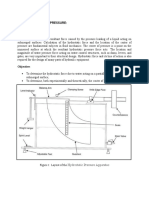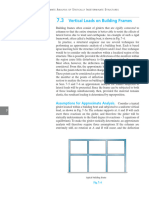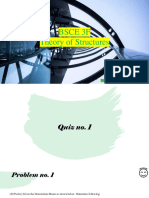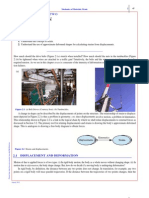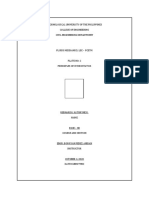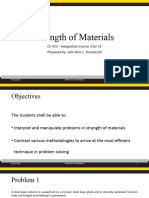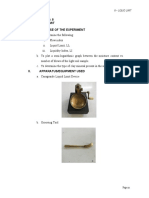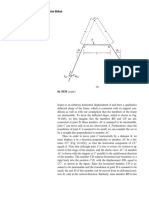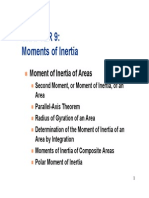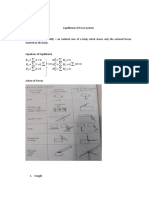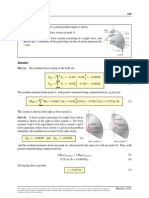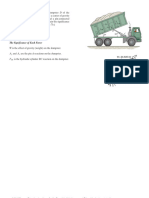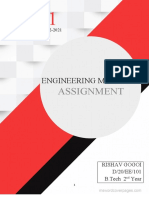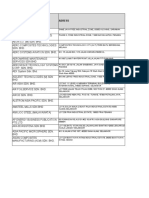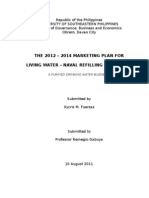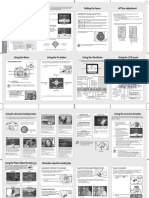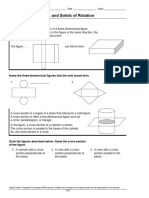Problem 5.6 The masses of the person and the diving board are 54 kg and 36 kg, respectively.
Assume that they are in equilibrium. (a) Draw the free-body diagram of the diving board. (b) Determine the reactions at the supports A and B.
B WD 1.2 m 2.4 m 4.6 m WP
Solution:
(a) (b) (N) (N) FX = 0: FY = 0: AX = 0 AY + BY (54)(9.81) 36(9.81) = 0
A B WD 1.2 m 2.4 m 4.6 m WP
MA = 0: 1.2BY (2.4)(36)(9.81) (4.6)(54)(9.81) = 0 Solving: AY BY AX =0N = 1.85 kN = 2.74 kN
4.6 m 2.4 m AX 1.2 m
AY
BY
WD
WP
Problem 5.7 The ironing board has supports at A and B that can be modeled as roller supports. (a) Draw the free-body diagram of the ironing board. (b) Determine the reactions at A and B.
B 10 lb 3 lb 20 in
12 in
10 in
Solution:
(a) (b)
The system is in equilibrium. The free-body diagram is shown. The sums of the forces are:
Substitute into the force balance equation: FA = 13 FB = 15.833 lb
FX = 0, FY = FA + FB 10 3 = 0. The sum of the moments about A is MA = 12FB 22(10) 42(3) = 0, from which FB = 346 = 28.833 in. 12
y A 12 in B 10 in 10 lb 20 in x 3 lb
FA
FB
10 lb
3 lb
�Problem 5.17 With each of the devices shown you can support a load R by applying a force F . They are called levers of the rst, second, and third class. (a) The ratio R/F is called the mechanical advantage. Determine the mechanical advantage of each lever. (b) Determine the magnitude of the reaction at A for each lever. (Express your answer in terms of F .)
F A
R A
First-class lever F A
Second-class lever R
Third-class lever
Solution:
(a)
Lever of rst kind. The sum of the forces is
F A
FY = F + A R = 0. The sum of the moments about A is MA R from which F (b) = F L RL = 0, L = =1 L
The reaction at A is obtained from the force balance equation:
R A
A = R + F = 2F (a) Lever of second kind. The sum of forces is FY = A R + F = 0. The sum of the moments about A is MA R from which F (b) = LR + 2LF = 0, 2L = =2 L
F A
The reaction at A is obtained from the force balance equation:
A = F + R = F + 2F = F (a) Lever of third kind. The sum of forces is FY = A R + F = 0. The sum of moments about A is: MA from which: (b) R F = 2LR + LF = 0, = L 1 = 2L 2 F F = , 2 2
From the force balance equation
A = F + R = F + |A| = F 2
�Problem 5.27 The airplanes weight is W = 2400 lb. Its brakes keep the rear wheels locked. The front (nose) wheel can turn freely, and so the ground exerts no horizontal force on it. The force T exerted by the airplanes propeller is horizontal. (a) Draw the free-body diagram of the airplane. Determine the reaction exerted on the nose wheel and the total normal reaction on the rear wheels (b) when T = 0, (c) when T = 250 lb. Solution:
the forces: FX = BX = 0 FY = AY W + BY = 0. The sum of the moments about A is MA = 5W + 7BY = 0, from which BY = 5W = 1714.3 lb 7 Substitute from the force balance equation: AY = W BY = 685.7 lb (c) The sum of the forces: FX = 250 + BX = 0, from which BX = 250 lb FY = AY W + BY = 0. The sum of the moments about A: MA = (250)(4) 5W + 7BY = 0, from which BY = 1571.4 lb. Substitute into the force balance equation to obtain: AY = 828.6 lb (a) The free body diagram is shown. (b) The sum of
4 ft
W A
5 ft
2 ft
T 4 ft W A 5 ft 2 ft B
4 ft
A AY 5 ft
W 2 ft
B BY
BX
�Problem 5.38
Determine the reactions at A.
A 300 lb 800 ft-lb 200 lb 200 lb 6 ft 3 ft 5 ft
Solution:
The built-in support at A is a two-force and couple reaction support. The sum of the forces for the system is FX = AX + 200 = 0,
from which AX = 200 lb FY = AY + 300 200 = 0, from which AY = 100 lb The sum of the moments about A: M = 6(300) + 5(200) 800 + MA = 0, from which MA = 1600 ft lb which is the couple at A.
A 300 lb 5 ft 800 ft-lb 200 lb 6 ft 3 ft 200 lb AY MA 300 lb 200 lb 6 ft 3 ft AX 5 ft 800 ft-lb 200 lb
�Problem 5.50
Determine the reactions at the supports.
6 in A 3 in 100 in-lb 5 in 50 lb
3 in B 30
Solution: The reaction at A is a two-force reaction. The reaction at B is one-force, normal to the surface. The sum of the forces:
FX = AX B cos 60 50 = 0. FY = AY + B sin 60 = 0. The sum of the moments about A is MA = 100 + 11B sin 60 6B cos 60 = 0, from which B = 100 = 15.3 lb. (11 sin 60 6 cos 60 )
6 in A 3 in 3 in
5 in
50 lb
100 in lb B 30
AX AY 100 11 in. B 60 50 lb 6 in.
Substitute into the force equations to obtain AY = B sin 60 = 13.3 lb and AX = B cos 60 + 50 = 57.7 lb
Problem 5.51 The weight W = 2 kN. Determine the tension in the cable and the reactions at A.
A 30
W 0.6 m 0.6 m
Solution:
Equilibrium Eqns: AX + T cos 30 = 0 AY + T + T sin 30 W = 0 (0, 6)(W ) + (0.6)(T sin 30 ) + (1, 2)(T ) = 0
FX = 0: FY = 0: + MA = 0:
30
W 0.6 m AY T AX 0.6 m 30 0.6 m W = 2 kN = 2000 N T 0.6 m
Solving, we get AX = 693 N, AY = 800 N, T = 800 N
�Problem 5.60 The weight W1 = 1000 lb. Neglect the weight of the bar AB. The cable goes over a pulley at C. Determine the weight W2 and the reactions at the pin support A.
50 W1 A
35 C
W2
Solution: The strategy is to resolve the tensions at the end of bar AB into x- and y-components, and then set the moment about A to zero. The angle between the cable and the positive x axis is 35 . The tension vector in the cable is
T2 = W2 (i cos(35 ) + j sin(35 )). = W2 (0.8192i 0.5736j)(lb). Assume a unit length for the bar. The angle between the bar and the positive x-axis is 180 50 = 130 . The position vector of the tip of the bar relative to A is rB = i cos(130 ) + j sin(130 ), = 0.6428i + 0.7660j. The tension exerted by W1 is T1 = 1000j. The sum of the moments about A is: MA = (rB T1 ) + (rB T2 ) = rB (T1 + T2 ) =L i 0.6428 0.8191W2 j 0.7660 0.5736W2 1000
W1
50
35
W2
35 T2 T1 50 AY AX rB
MA = (0.2587W2 + 642.8)k = 0, from which W2 = 2483.5 lb The sum of the forces: FX = (AX + W2 (0.8192))i = 0, from which AX = 2034.4 lb FY = (AY W2 (0.5736) 1000)j = 0, from which AY = 2424.5 lb
�Problem 5.66 Consider the beam in Problem 5.69. Choose supports at A and B so that it is not statically indeterminate. Determine the reactions at the supports. Solution: One possibility is shown: the pinned support at B is replaced by a roller support. The equilibrium conditions are:
FX = AX = 0. The sum of moments about A is MA = M + 1.1BY = 0, from which BY = 20 = 18.18 N. 1.1
20 N-m B 800 mm 300 mm 20 N-m
AX AY 800 mm
The sum of forces in the vertical direction is FY = AY + BY = 0, from which AY = BY = 18.18 N.
300 mm
BY
Problem 5.67 (a) Draw the free-body diagram of the beam and show that it is statically indeterminate. (The external couple M0 is known.) (b) By an analysis of the beams deection, it is determined that the vertical reaction B exerted by the roller support is related to the couple M0 by B = 2M0 /L. What are the reactions at A? Solution:
(a) FX : FY : + MA : AX = 0 AY + B = 0 (1) (2)
M0 A L B
M0
A L
MA MO + BL = 0 (3)
Unknowns: MA , AX , AY , B. 3 Eqns in 4 unknowns Statistically indeterminate (b) Given B = 2MO /L (4)
AY MA AX L
MO
We now have 4 eqns in 4 unknowns and can solve. Eqn (1) yields AX = 0 Eqn (2) and Eqn (4) yield AY = 2MO /L Eqn (3) and Eqn (4) yield MA = MO 2MO MA = MO MA was assumed counterclockwise MA = |MO | clockwise AX = 0 AY = 2MO /L
�Problem 5.77 The force exerted on the highway sign by wind and the signs weight is F = 800i 600j (N). Determine the reactions at the built-in support at O. Solution: The force acting on the sign is
F = FX i + FY j + FZ k = 800i 600j + 0k N, and the position from O to the point on the sign where F acts is r = 0i + 8j + 8k m. The force equations of equilibrium for the sign are OX + FX = 0, OY + FY = 0, and OZ + FZ = 0. Note that the weight of the sign is included in the components of F. The moment equation, in vector form, is M = MO + r F. Expanded, we get M = MOX i + MOY j + MOZ k + The corresponding scalar equations are MOX (8)(600) = 0, MOY + (8)(800) = 0, and MOZ (8)(800) = 0. Solving for the support reactions, we get OX = 800 N, OY = 600 N, OZ = 0, MOX = 4800 N-m, MOY = 6400 N-m, and MOZ = 6400 N-m. i 0 800 j 8 600 k 8 = 0. 0
y F
CCON TU
8m
8m
O x
y F
8m OY MO 8m OZ z OX x
the sign is (4.4)(70)2 N = 21.56 kN. The force acting on the sign is F = FX i + FY j + FZ k = 21560i 600j + 0k N, and the position from O to the point on the sign where F acts is r = 0i + 8j + 8k m. The force equations of equilibrium for the sign are OX + FX = 0, OY + FY = 0, and OZ + FZ = 0.
Problem 5.78 In Problem 5.81, the force exerted on the sign by wind and the signs weight is F = 4.4v 2 i 600j (N), where v is the component of the winds velocity Expanded, we get perpendicular to the sign in meters per second (m/s). i j k 0 8 8 = 0. M = MOX i + MOY j + MOZ k + If you want to design the sign to remain standing in 21560 600 0 hurricane winds with velocities v as high as 70 m/s, what reactions must the built-in support at O be designed to The corresponding scalar equations are withstand? MOX (8)(600) = 0, Solution: The magnitude of the wind component of the force on MOY + (8)(21560) = 0,
and MOZ (8)(21560) = 0. Solving for the support force reactions, we get OX = 21560 N, OY = 600 N, OZ = 0, and for moments, MOX = 4800 N-m, MOY = 172,500 N-m, and MOZ = 172,500 N-m.
Note that the weight of the sign is included in the components of F. The moment equation, in vector form, is M = MO + r F.
�Problem 5.87 The 158,000-kg airplane is at rest on the ground (z = 0 is ground level). The landing gear carriages are at A, B, and C. The coordinates of the point G at which the weight of the plane acts are (3, 0.5, 5) m. What are the magnitudes of the normal reactions exerted on the landing gear by the ground?
21 m 6m B G C 6m A x
Solution:
FY = (NL + NR ) + NF W = 0 MR = 3 mg + 21NF = 0 Solving, NF = 221.4 kN (1) (NL + NR ) = 1328.6 kN (2) F Y = NR + NL + NF W = 0 (same equation as before) + MO = 0.5 W 6(NR ) + 6(NL ) = 0 (3)
y 6m 6m B G C A x 21 m
Solving (1), (2), and (3), we get NF = 221.4 kN NR = 728.9 kN NL = 599.7 kN
mg 3m 21 m
Side View R (NL + NR) Z W 0.5 m F NF
Front View
6 NF NL
NR
�Problem 5.93 In Problem 5.95, the vertical force F = 4 kN. The bearing at A will safely support a force of 2.5-kN magnitude and a couple of 0.5 kN-m magnitude. Based on these criteria, what is the allowable range of the distance b? Solution: The solution to Prob. 5.95 produced the relations
AY + B F = 0 F b 0.3B = 0 MAZ + 0.2F 0.2B = 0 AX = AZ = MAX = MAY = 0 Set the force at A to its limit of 2.5 kN and solve for b. In this case, MAZ = 0.5 (kN-m) which is at the moment limit. The value for b is b = 0.1125 m (F = 4 kN )
We make AY unknown, b unknown, and B unknown (F = 4 kN, MAY = +0.5 (kN-m), and solve we get AY = 2.5 at b = 0.4875 m However, 0.3 is the physical limit of the device. Thus, 0.1125 m b 0.3 m
b A x
B z 0.3 m
0.2 m
Problem 5.94 The 1.1-m bar is supported by a ball and socket support at A and the two smooth walls. The tension in the vertical cable CD is 1 kN. (a) Draw the free-body diagram of the bar. (b) Determine the reactions at A and B. Solution:
(a) The ball and socket cannot support a couple reaction, but can support a three force reaction. The smooth surface supports oneforce normal to the surface. The cable supports one force parallel to the cable. (b) The strategy is to determine the moments about A, which will contain only the unknown reaction at B. This will require the position vectors of B and D relative to A, which in turn will require the unit vector parallel to the rod. The angle formed by the bar with the horizontal is required to determine the coordinates of B: 0.62 + 0.72 = cos1 = 33.1 . 1.1 The coordinates of the points are: A (0.7, 0, 0.6), B (0, 1.1 (sin 33.1 ), 0) = (0, 0.6, 0), from which the vector parallel to the bar is rAB = rB rA = 0.7i + 0.6j 0.6k (m). The unit vector parallel to the bar is eAB rAB = = 0.6364i + 0.5455j 0.5455k. 1.1 = (1.1 0.4)eAB = 0.7eAB = 0.4455i + 0.3819j 0.3819k. The reaction at B is horizontal, with unknown x-component and z-components. The sum of the moments about A is MA = rAB B + rAD i + 0.4455 0 i D = 0 = 0.7 BX k 0.3819 = 0 0 j 0.6 0 k 0.6 BZ
400 mm D x C A 600 mm
700 mm
Expand and collect like terms: MA = (0.6BZ 0.3819)i (0.6BX 0.7BZ )j +(0.6BX + 0.4455)k = 0. From which, BZ = BX = 0.3819 = 0.6365 kN, 0.6 0.4455 = 0.7425 kN. 0.6
The reactions at A are determined from the sums of the forces: FX = (BX + AX )i = 0, from which AX = 0.7425 kN. FY = (AY 1)j = 0, from which AY = 1 kN. FZ = (BZ + AZ )k = 0, from which AZ = 0.6365 kN
The vector location of the point D relative to A is rAD
y FB B D
400 m T x 600 m A FZ FX FY
j 0.3819 1
C z 700 m
�Problem 5.109 The plate is supported by hinges at A and B and the cable CE, and it is loaded by the force at D. The edge of the plate to which the hinges are attached lies in the y z plane, and the axes of the hinges are parallel to the line through points A and B. The hinges do not exert couples on the plate. What is the tension in cable CE?
3m 2i 6j (kN) E A D 2m B 20 2m C
1m z
Solution:
F = A + B + FD + TCE = 0 However, we just want tension in CE. This quantity is the only unknown in the moment equation about the line AB. To get this, we need the unit vector along CE. Point C is at (2, 2 sin 20 , 2 cos 20 ) Point E is at (0, 1, 3) eCE = rCE |rCE |
3m 2i 6j (kN) E A D 2m B 20 C 2m
eCE = 0.703i + 0.592j + 0.394k We also need the unit B(0, 2 sin 20 , 2 cos 20 ) vector eAB . A(0, 0, 0),
1m z
eAB = 0i 0.342j + 0.940k The moment of FD about A (a point on AB) is MFD = rAD FD1 = (2i) (2i 6j) MFD = 12k The moment of TCE about B (another point on line CE) is MTCE = rBC TCE eCE = 2i TCE eCE , where eCE is given above. The moment of FD about line AB is MF DAB = MF D eAB MF DAB = 11.27 N-m The moment of TCE about line AB is MCEAB = TCE (2i eCE ) eAB MCEAB = TCE (0.788j + 1.184k) eAB MCEAB = 1.382TCE The sum of the moments about line AB is zero. Hence MF DAB + MCEAB = 0 11.27 + 1.382TCE = 0 TCE = 8.15 kN
3m
E A
AY AX AZ TCE
FD = 2i 6j D x
1m
z BZ
BY B BX
2m
C
20
2m
�Problem 5.113 The bearings at A, B, and C do not exert couples on the bar and do not exert forces in the direction of the axis of the bar. Determine the reactions at the bearings due to the two forces on the bar.
C
y 200 i (N) 300 mm x 180 mm B z A 100 k (N) 150 mm 150 mm
Solution: The strategy is to take the moments about A and solve the resulting simultaneous equations. The position vectors of the bearings relative to A are:
rAB = 0.15i + 0.15j, rAC = 0.15i + 0.33j + 0.3k. Denote the lower force by subscript 1, and the upper by subscript 2: rA1 = 0.15i, rA2 = 0.15i + 0.33j. The sum of the moments about A is: MA = rA1 F1 + rAB B + rA2 F2 + rAC C = 0 i MA = 0.15 0 i + 0.15 200 j 0 0 k i 0 + 0.15 100 BX j 0.15 0 k 0 BZ k 0.3 = 0 0
y 300 mm 200 i (N)
C B z
180 mm
A 100 k (N) y CY CX BZ 100 N 200 N 150 mm
150 mm x
j k i 0.33 0 + 0.15 CX 0 0
j 0.33 CY
x z BX AY AZ
MA = (0.15BZ 0.3CY )i + (15 + 0.15BZ + 0.3CX )j +(0.15BX 66 0.15CY 0.33CX )k = 0. This results in three equations in four unknowns; an additional equation is provided by the sum of the forces in the x-direction (which cannot have a reaction term due to A) FX = (BX + CX + 200)i = 0. The four equations in four unknowns: 0BX + 0.15BZ + 0CX 0.3CZ = 0 0BX + 0.15BZ + 0.3CX + 0CY = 15 0.15BX + 0BZ 0.33CX 0.15CY = 66 BX + 0BZ + CX + 0CZ = 200. (The HP-28S hand held calculator was used to solve these equations.) The solution: BX = 750 N, BZ = 1800 N, CX = 950 N, CY = 900 N. The reactions at A are determined by the sums of forces: FY = (AY + CY )j = 0, from which AY = CY = 900 N FZ = (AZ + BZ + 100)k = 0, from which AZ = 1900 N
�Problem 5.128 A rectangular plate is subjected to two forces A and B (Fig. a). In Fig. b, the two forces are resolved into components. By writing equilibrium equations in terms of the components Ax , Ay , Bx , and By , show that the two forces A and B are equal in magnitude, opposite in direction, and directed along the line between their points of application.
A
B A h
b (a) y By B Ay A Ax b (b) h x Bx
Solution:
The sum of forces:
FX = AX + BX = 0, from which AX = BX FY = AY + BY = 0, from which AY = By . These last two equations show that A and B are equal and opposite in direction, (if the components are equal and opposite, the vectors are equal and opposite). To show that the two vectors act along the line connecting the two points, determine the angle of the vectors relative to the positive x-axis. The sum of the moments about A is MA = Bx (h) bBy = 0, from which the angle of direction of B is tan1 BY BX = tan1 h b = B .
b B h A y Ay Fig a By
Bx
Ax
Fig b x
or (180 + B ). Similarly, by substituting A: tan1 AY AX = tan1 h b = A ,
or (180 + A ). But = tan1 h b
describes direction of the line from A to B. The two vectors are opposite in direction, therefore the angles of direction of the vectors is one of two possibilities: B is directed along the line from A to B, and A is directed along the same line, oppositely to B.
�Problem 5.137 To determine the location of the point where the weight of a car acts (the center of mass), an engineer places the car on scales and measures the normal reactions at the wheels for two values of , obtaining the following results: Ay (kN) B (kN) 10 10.134 4.357 20 10.150 3.677 What are the distances b and h?
B W
Ax Ay 2.7 m
Solution:
rB = 2.7i.
The position vectors of the cm and the point B are
rCM = (2.7 b)i + hj, The angle between the weight and the positive x-axis is = 270 . The weight vector at each of the two angles is W10 = W (i cos 260 + j sin 260 ) W10 = W (0.1736i 0.9848j) W20 = W (i cos 250 + j sin 250 ) or W20 = W (0.3420i 0.9397j) The weight W is found from the sum of forces: FY = AY + BY + W sin = 0, from which W AY + BY = . sin
These two simultaneous equations in two unknowns were solved using the HP28S hand held calculator. b = 1.80 m, h = 0.50 m
y B W
h x
A y
Ax 2.7 m
Taking the values from the table of measurements: W10 = 10.134 + 4.357 = 14.714 kN, sin 260 10.150 + 3.677 = 14.714 kN check ] sin 250
[check :W20 =
The moments about A are MA = rCM W + rB B = 0. Taking the values at the two angles: M10 = A i 2.7 b 2.5551 j h 14.4910 k i 0 + 2.7 0 0 j 0 4.357 k 0 =0 0
= 14.4903b + 2.5551h 27.3618 = 0 M20 = A i 2.7 b 5.0327 j h 13.8272 k i 0 + 2.7 0 0 j 0 3.677 k 0 0
= 013.8272b + 5.0327h 27.4054 = 0

